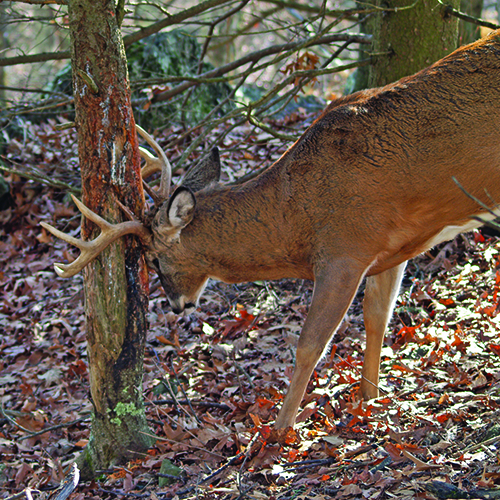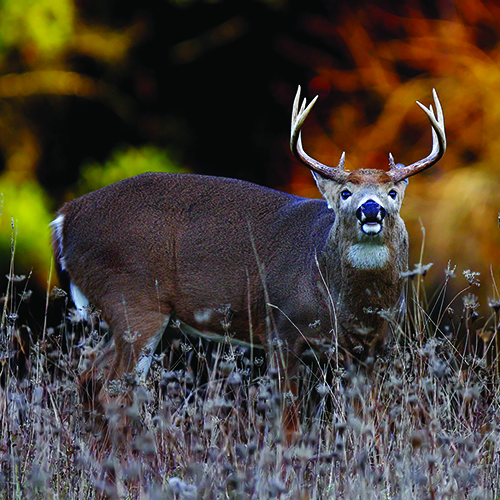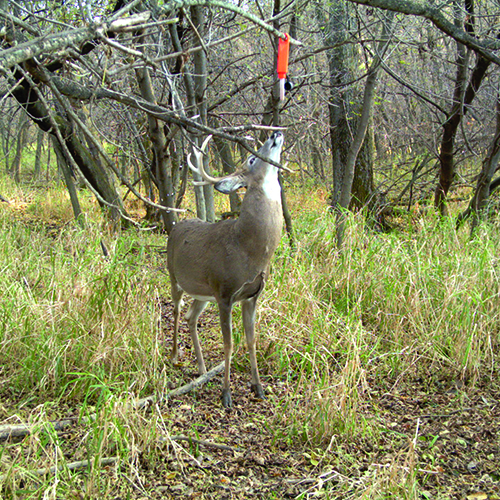D+DH In-Depth is our premium, comprehensive corner on America’s No. 1 game animal. In this graduate-level course, we’ll teach you about deer biology, behavior, and ultimately, how to become a better hunter. Want to be the first to get our premium content? Become a D+DH Insider for FREE!
How many scent glands does a white-tailed deer have and what are their functions? The answers might surprise you.
By Darren Warner
To deer hunters, few things smell as bad as a tarsal gland hidden in a lunch box. One of my hunting buddies is a huge practical joker. His past exploits include replacing odorless wind-detection powder with feminine hygiene powder, putting cayenne pepper in hunting boots and placing a stuffed skunk toy in a deer blind.
He’s also a big believer in using tarsal glands from harvested deer to lure other whitetails into shooting range. One cold November morning, he placed a frozen tarsal gland between two slices of rye bread and put the “sandwich” in my lunch box. By noon, the odor emanating from my lunch box overwhelmed me. I made the best of it by taking my food out of the box and hanging both the lunch box AND the tarsal gland in a maple 30 yards upwind.
I was the one who got the last laugh. The tarsal gland lured a beautiful 8-pointer with 9-inch-long brow tines right to my stand, and I arrowed him at 20 yards.
Many hunters believe using gland scents can improve their success. For those who aren’t scent-savvy, tarsal gland scents aren’t the only game in town. Scientists have identified several different glands in deer, and many companies have developed specialized gland lures that target different whitetail receptors. Let’s look at what researchers know — and don’t know — about deer glands. Then let’s explore how to successfully use them, and take a look at which states have outlawed natural deer scents and why.
Whitetail Gland Anatomy
A pop quiz: Name all of the different glands white-tailed bucks have. If you stopped at tarsal and interdigital glands, you need to go back to whitetail anatomy school. White-tailed deer have at least seven different glands found in specific areas of their bodies. While scientists have speculated on the purpose of each one, the truth is researchers know relatively little about what role (if any) each gland plays in deer communication.
Hunters and wildlife biologists alike are most knowledgeable about whitetail tarsal glands. Found on the inside of the rear hocks, tarsal glands are a type of sebaceous gland that secretes fatty lipids called sebum. By themselves, tarsal glands don’t tell deer much about each other.
“Tarsal glands are relatively odorless,” said Brian Murphy, CEO of the Quality Deer Management Association. “It’s only when a deer urinates on them and the urine decomposes that they give each deer its unique odor that serves as an ID card for other deer.”
Notice that Murphy said when deer urinate on them, because bucks, does and even fawns rub-urinate year-round, although bucks do it more often during the breeding season. Scientists speculate that tarsal glands provide whitetails with information on a deer’s dominance status, sex, health and perhaps even a buck’s willingness to breed. This would explain why researchers have found that older, more dominant bucks tend to rub-urinate more frequently, particularly during the rut. The precise mixture of bacteria that grows in the hairs around tarsal glands, which is unique from deer to deer, is likely deposited in scrapes when a deer rub-urinates, communicating information to other deer that visit the scrapes.

Handle tarsal glands with care. “Tarsal glands hold a lot of different bacteria that can make humans very sick,” explained Dr. Karl Miller, professor of wildlife biology at the University of Georgia’s Warnell School of Forestry and Natural Resources. Always wear exam or rubber gloves when handling tarsal glands, and wash your hands thoroughly after handling any gland scent.
Metatarsal Glands: Next are the metatarsal glands, which are found on the lower outside portion of the hind legs. Like tarsal glands, metatarsal glands are relatively odorless. They’re also larger in Northern whitetails than in subspecies found in the South and Mexico. Some scientists believe metatarsal glands might help whitetails in cold climates regulate their body temperature and conserve energy, although this is mostly speculation.
Interdigital Glands: Between the hooves of every deer are interdigital glands, which produce rancid compounds that smell something like sour butter. These glands manufacture a plethora of chemical compounds that dissipate at different rates, so scientists suspect a deer can discern the age of a deer track and perhaps even a deer’s direction of travel by smelling its hoof prints.
Preputial Glands: Preputial glands lubricate the penal sheath. Scientists don’t know if they communicate any scent information, although some believe they might play a role in giving a rutting buck its identifiable scent.
Nasal Glands: All deer also have nasal glands found inside their nostrils. These glands might serve the purpose of lubricating the nose, but scientists aren’t sure.
Preorbital Glands: Located at the bases of both eyes are preorbital glands, which release a substance when a deer rubs its eyes against bushes, trees and other vegetation. The truth is that scientists are unsure if preorbital glands release scent or merely serve to lubricate the eyes.
Forehead Glands: Finally, bucks and does use forehead glands to disperse their scent on licking branches and rubs. Forehead glands tend to be more active in mature bucks and during breeding season. Scent left behind by forehead glands lasts for days, leading some researches to speculate that the glands communicate a buck’s age, social status and readiness to breed. Studies have shown that beagles can track specific deer from scent emitted by their forehead glands.
Deer hunters disagree about a lot of things, and nowhere is this more evident than when talking about deer lures. Some hunters consistently use gland lures to pique the interest of deer, while others think it’s a complete waste of time and money. There have been several studies on buck behaviors that all agree on one finding: Bucks are individuals with unique preferences, so gland scents won’t attract all of them. And even deer that are seemingly lured into shooting range by a scent aren’t necessarily reacting to the scent the way hunters think they are.
“Some of the glands communicate information about a deer — they don’t really attract other deer,” explained Miller. “If gland odors were as attractive as some hunters think, then they would bring all the deer in one area to the scent, and we know that doesn’t happen.”

Instead, Miller and other scientists posit that gland scents pique the curiosity of some deer, compelling them to investigate the unidentified odor, which often leads them right into a hunter’s shooting lane.
Regardless of why gland scents work, they do help many hunters consistently fill their deer tags. Let’s look at some strategies for successfully using glandular scents.
Dos and Don’ts of Scent Dispersal
Regardless of the type of scent you’re using, there are several things you can do to increase the odds of an attractant working for you, and some things you need to avoid.
Place scents upwind of your stand and to the right and left sides, so a deer doesn’t come into the scent stream you left behind when putting out the scent. Place the scent where deer will look directly away from you to inspect it, like on the side of a trail farthest away from your stand.
All scents disperse best in humid weather when there’s a light breeze. In dry, windy conditions, odors don’t travel far or predictably. Similarly, wet conditions prevent scent from traveling as far.
Wearing gloves when handling scents not only prevents you from getting sick, but helps avoid contaminating the lure with human scent. Avoid touching bushes, limbs, tall grass or any other vegetation with ungloved hands and clothing. The same goes for the hat on your head. How many times have you accidentally hit your cap on a branch hanging over a spot where you were creating a mock scrape? If this happens, either find another spot to place your scent or hose down the area with a scent-killing spray. Speaking of scrapes, it’s best to create a mock scrape near one made by the real McCoy, rather than adding your own gland scent(s) to an existing scrape.
“It’s very easy to accidentally contaminate a scrape with your scent or by doing something else to the scrape that frightens deer,” said Sam Burgeson, president of Wildlife Research Center. “By setting up a competing scrape, you lower the risk of contaminating the area.”
Don’t forget to add preorbital and/or forehead gland lure to the licking branch. Bucks will work licking branches all year long, with chewing/licking activity peaking during the pre-rut. You can also apply preorbital and forehead gland scents to rubs.
If you’ve read anything about when to use scents, you’ve undoubtedly been told to use certain scents at only certain times of the year (e.g., use estrous scents only at breeding time). Poppycock, says Burgeson.
“We have a lot of pro staffers who put out scents containing estrous urine as early as August to create hotspots that deer start coming to investigate,” he said. “We’ve seen that putting out these scents early can also encourage scrape-making activity in those areas.”
Again, deer are individuals, so they’re not all going to respond to scents the same way. Use game cameras to monitor how deer react to scents you’ve put out. Set cameras where you can observe deer behavior 10 to 20 yards away from scent-dispersal sites. Not all deer will come right up to your scent pad or mock scrape for a close inspection, and you won’t be able to evaluate how all deer respond to your scent if you put your camera right on top of a scent site.

Use interdigital gland scent anytime you want to entice deer to follow a trail you’ve laid down. Start by spraying down your rubber boots with scent-killing spray. Then saturate a boot pad or drag, and walk slowly to your stand. And don’t overuse any scent.
“Only use a particular scent at a site a couple of times, then switch to another scent,” said Paul Pollick, owner of Pollick’s Deer Scents. “You want deer to keep coming back to the site to see what other deer have been in the area.”
Another trick Pollick recommends is to place preorbital scent on mock rubs you create in your shooting lanes. Deer will stop to investigate, giving you more time to shoot.
Finally, get creative when dispensing scents. I’ve found that many bucks can’t resist inhaling deeply and then chewing on a licking branch covered in tarsal gland scent. Try several different scents and scent combinations, do everything you can to keep your own scent out of the woods, and closely monitor how deer respond to your scent sites. You’ll learn what works where you hunt, and make scents work better for you.
— Darren Warner is a passionate deer hunter, freelance writer and photographer. He lives in Michigan and is obsessed with white-tailed deer.
Want to be the first to get our premium content? Become a D+DH Insider for FREE!












































